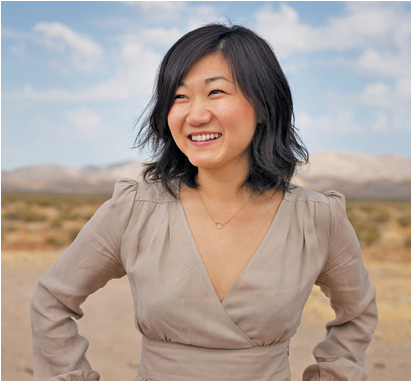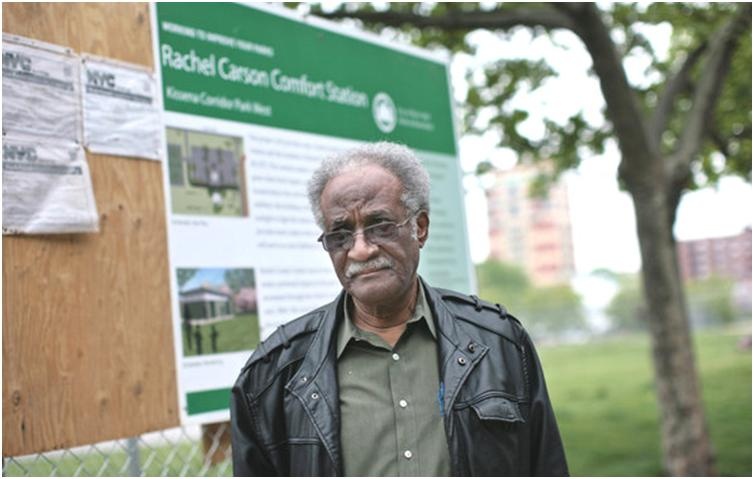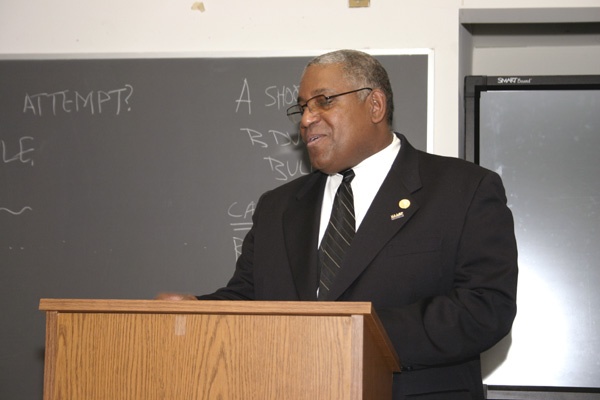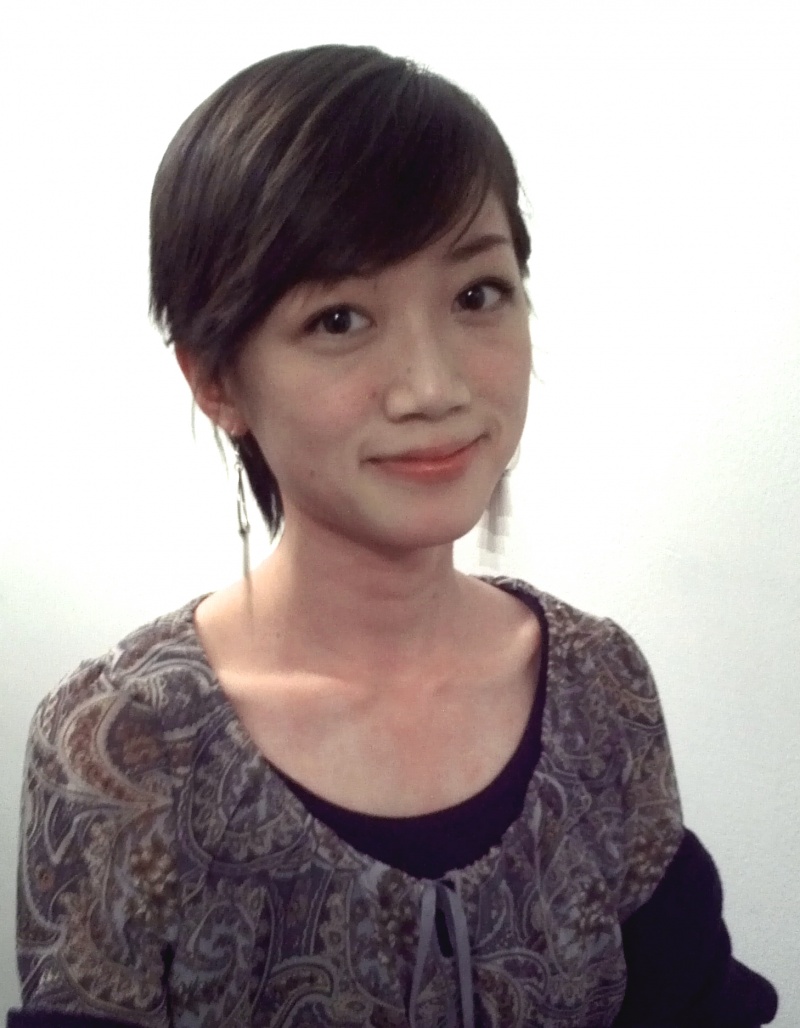Character Study
A Crusade for Comfort in the Park
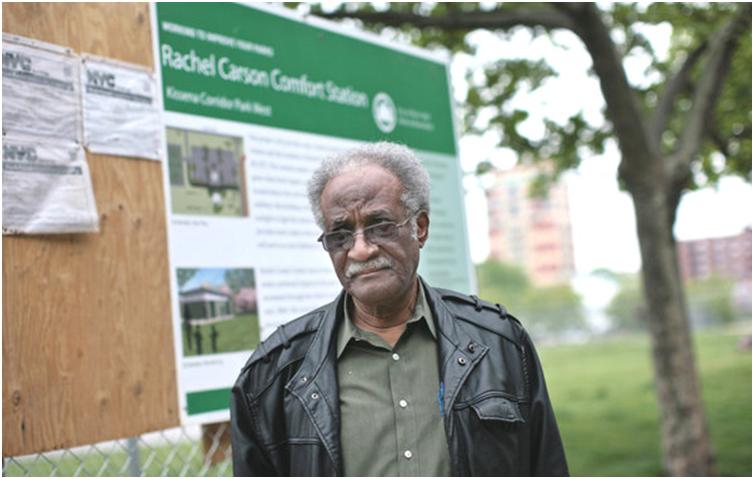
Marcus Yam for The New York Times
SPOKE UP John Henry Byas fought a long battle for a public restroom.
By COREY KILGANNON
Published: May 4, 2012
GROWING up on a farm in South Carolina, John Henry Byas had only an outhouse and a chamber pot when nature called.
"It definitely teaches you the importance of having a bathroom nearby," he said on Thursday outside the apartment building in Flushing, Queens, where he has lived since 1974, opposite a stretch of athletic fields and courts along Colden Street in Kissena Corridor Park. "My apartment's got two bathrooms now, so this whole thing was never about me."
This whole thing is Mr. Byas's 30-year crusade to bring a modern outhouse to users of a busy section of a city park with no public restrooms.
From his terrace, Mr. Byas, 77, would watch parkgoers — and the many pedestrians walking to and from schools and hospitals — seeking relief. "There are no businesses around," he said, "so they would relieve themselves in the bushes in front of my building, in broad daylight."
Mr. Byas figured that he would just get the parks department to build a restroom. That was in 1981. He learned that the local Community Board 7 offered a public comment period at its meetings, so he showed up and delivered the first of what over the years would turn out to be, by his count, more than 100 impassioned public pleas to community groups.
"The right person could have gotten this done with one phone call," he said. "But I had no voice, no power. I didn't know the right people. I realized I had to build connections."
And so, from a single cause, a local activist was born. Mr. Byas wound up joining dozens of local groups and boards. He collected signatures. He met with local elected officials and parks department higher-ups. Mr. Byas's battle is a study in how a regular Joe can piece together the power to get something done in this city over three decades. And now it has finally paid off: The toilets are on their way and scheduled to open by September.
These past few weeks, an elated Mr. Byas has been watching the skeleton rise in the park, opposite his fifth-floor, rent-regulated apartment.
"I picked the spot," he said. "It's convenient for everyone, and I can keep an eye on it."
After high school, Mr. Byas served four years in the Navy during the Korean War and then settled in New York City, becoming an elevator supervisor at Memorial Sloan-Kettering Cancer Center in Manhattan. In 2000, he retired after 41 years. He and his wife, Johnnie Mae Byas, have three children, seven grandchildren and three great-grandchildren.
"But I feel like this is one of my children," Mr. Byas said, looking at the bathroom-in-progress. "I fought like hell for this for 30 years."
That fight involved joining groups like the youth program at the nearby Intermediate School 237. He became a pastor's assistant at the Macedonia African Methodist Episcopal Church, over on Union Street. He became president of his building's tenants association and served on the 109th Precinct Community Council. He got onto the advisory boards of two hospitals, and joined the local Democratic club. The list goes on and on — as did the thousands of evening meetings he sat through.
Mr. Byas got himself appointed to the community board and supported members who would then back his bathroom agenda, and he served on numerous committees on the board. "The Budget Committee, that's the most important one," he said.
Eventually, he got the bathroom project listed — as 47th — on a priority list of capital projects, and it climbed slowly over the years, he said, but money was scarce until 2008, when the local city councilman, John C. Liu — now the city comptroller — called Mr. Byas to say he had secured money to build the bathroom: a modern, environmentally advanced one, with three toilets for women and two toilets and four urinals for men.
Mr. Byas said he wept when he heard the news.
"I wanted to see this bathroom built while I still walked this earth, and the fact that I will probably see it open before I die is very satisfying," he said.
On Thursday, he stood and watched the workers building it. A sign bore design sketches of the new Rachel Carson Comfort Station, with its green slate siding and sloping metal roof that will provide water runoff for an adjacent pocket garden.
Mr. Byas said he considered it a worthy monument to his crusade, which was really pretty simple in the end.
"I had no voice and I worked until I got a voice," he said.
E-mail: character@nytimes.com
Mr. Sherman, Principal of East West School of International Studies, adds:
Mr. Byas spoke recently in Muster about his quest to build a bathroom in the park across from our school. The fence that is currently around the children's playground and all the construction for the new bathroom is a result of this one man's struggle to provide the users of the park with the simple dignity of being able to relieve themselves in sanitary conditions without soiling the park or having to return to their homes. Let's pat him on the back for his efforts whenever we see him. Mr. Byas is a good man, and should be held up to our students as an example of what a single person can accomplish by being persistent. Mr. Byas is a role model for us all. Mr. Byas is a member of our East-West School Community Advisory Board.
